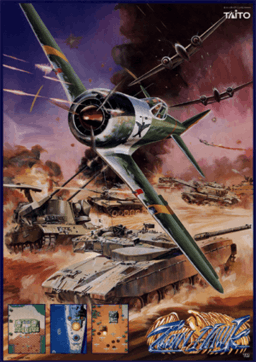Twin Hawk
|
European arcade flyer of Twin Hawk. | |
| Developer(s) | Toaplan |
|---|---|
| Publisher(s) | Taito |
| Platform(s) | Arcade, PC Engine, Sega Mega Drive |
| Release date(s) | 1989 |
| Genre(s) | Scrolling shooter |
| Cabinet | Upright |
| Display | Raster, standard resolution |
Twin Hawk, known in Japan as Daisenpū (大旋風), is a 1989 vertically scrolling shooter arcade game developed by Toaplan and published by Taito.
Gameplay

Twin Hawk resembles other shooters of the time, specifically Toaplan's earlier game, Flying Shark. Also like Toaplan's other games, there were various differences between the Japanese version and other versions, including a checkpoint system and higher difficulty for the former. Unusually, the game contains no flying enemies; thus, a complete lack of physical obstructions and a stronger focus on the numbers and speed of ground forces.
Another draw of Twin Hawk is the game's unique "smartbomb" in the form of a group of friendly planes; pressing button 2 once will call in six Flying Fortresses to surround and protect the player's plane, and provide back-up fire. They are easily taken down by enemy fire, so the player must use them wisely.
Pressing button 2 again immediately after the call-in will sacrifice the planes for a more typical smartbomb. Otherwise, pressing button 2 while any other plane is on-screen will suicide them all into the nearest enemies below.
Plot
At the end of an alternate World War II, a new European country is formed called Gorongo. General Giovanni of the Gorongo military was infuriated with the results of the war and what it meant to the country of Gorongo, initiating a rebellion against the country’s government that was widely followed by his soldiers. Holing themselves up on Bobo Island, south of Gorongo, Giovanni declared the occupation as the independent state of Fuangania and plotted to take over Gorongo. After taking over the town of Kusunoki, the Fuangania invasion – consisting of massive ground and sea attack forces – started to spread.
Gorongo President Bratt ordered a counterattack that focused on the one type of firepower Giovanni lacked: an air force. The special air force "Daisenpuu" sets up a mountain base after spotting a secret Fuangania fortress under construction. However, nearing the end of their training, the airforce is spotted by the Fuangania and are preparing to attack. It's up to the player, in the role of the Wing Commander, to fly into Giovanni's secret base and take him and his commanding unit out.
There is a different plot on the back of the flyer for the European arcade release.[1]
Ports and related releases
Twin Hawk was ported a year later by Sega to the Sega Mega Drive/Genesis in Japan on June 23, 1990, and in Europe on July 25, 1990. During the same year, it was ported and published by NEC Avenue to the PC Engine exclusively in Japan on December 14, 1990. On July 26, 1991, an enhanced re-issue of the PC Engine version for the PC Engine CD-ROM² titled Daisenpū Custom (大旋風 カスタム) was released, which is similar to the PC Engine version with the added benefit of arranged CD-DA soundtrack and additional stages and enemies.
Reception
On release, Famicom Tsūshin scored the Mega Drive version of the game a 30 out of 40.[2]
References
- ↑ http://flyers.arcade-museum.com/?page=flyer&db=videodb&id=2371&image=2
- ↑ 30 Point Plus: 大旋風. Weekly Famicom Tsūshin. No.309. Pg.39. 11–18 November 1994.
